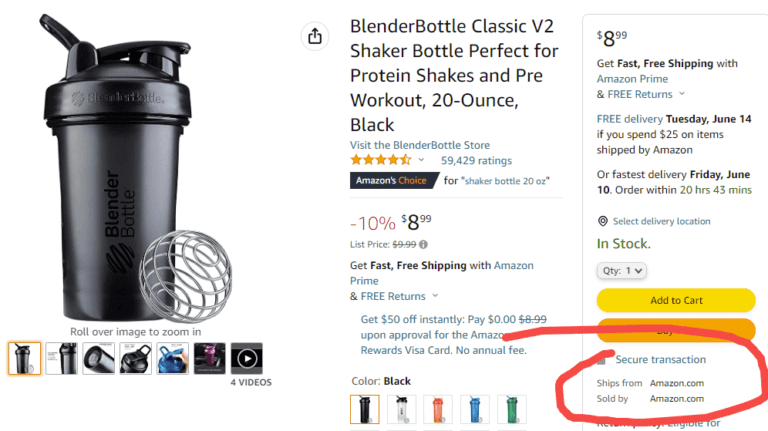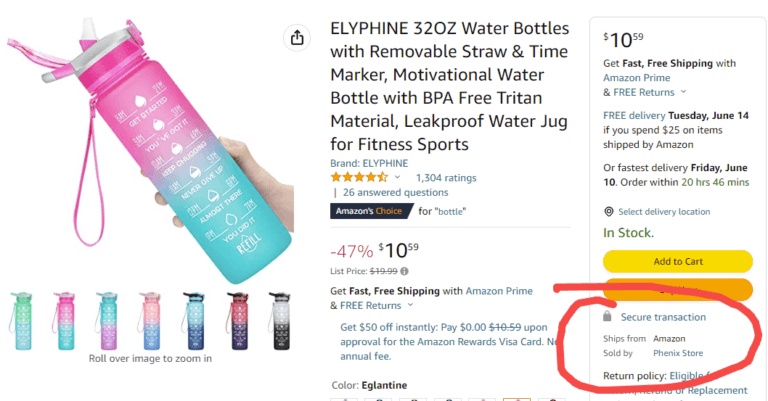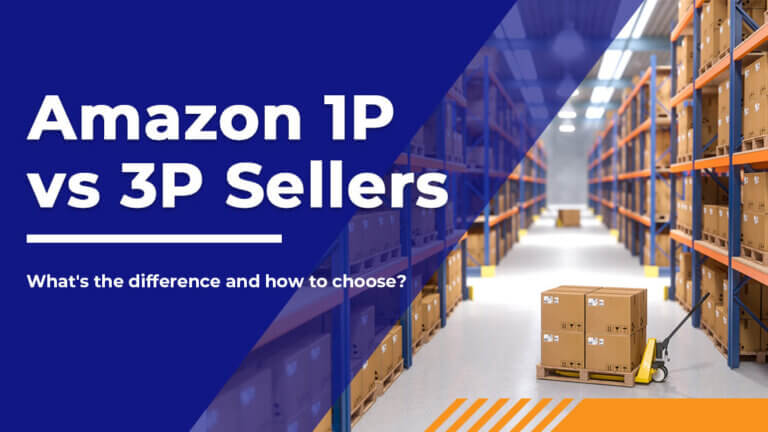If you’re a seller on Amazon (or if you’re interested in becoming one), you’ve probably heard of the 1P Amazon sellers and 3P Amazon sellers.
When you browse Amazon.com, you can easily see the difference in the “sold by” field. Sometimes the page displays “sold by Amazon”, and sometimes it displays “sold by a brand name” again. This is the big difference you can find between 1P and 3P Seller.
This essentially describes two modes of collaboration between sellers and The Amazon platform. But for beginners, these terms can be confusing at first. To simplify things, we’ll walk you through the definitions of these two names and show you how to choose the right one.
Let’s get started.
What Are 1P Amazon Sellers?
Amazon 1P (First-Party), aka, Vendor Central。
The first-party relationship with Amazon means that you sell your products directly to Amazon.
In this model, the customer buys from Amazon, not you. You act as a product supplier in the process. You supply goods to Amazon, and Amazon sells them to customers.
Since Amazon 1P Seller is only the supplier, they have no control over the price of the product. Amazon controls products by pricing them on the market, selling them to customers, and shipping them itself. To become a 1P seller, you must be directly invited by Amazon.
Amazon 1P sellers can manage products and get purchase orders by visiting the vendor center, where 1P sellers can also update product lists, and promote and advertise your products so that they sell faster and Amazon can buy more from you.
Characteristics of Amazon 1P sellers:
- 1P sellers assist with purchase orders and deliver them to the Amazon warehouse.
- The ownership of the products belongs to Amazon.
- Buyers can see that products are marked “Ships from and sold by Amazon”.
- Amazon sets and adjusts prices.
- The operations of 1P sellers on Amazon are completed through Vendor Central.

Pros and Cons of 1P Amazon Seller
Pros of 1P Amazon Seller
- Receive bulk POs from Amazon according to an established cadence.
- Amazon’s team optimizes the product detail pages.
- You can choose more advertising options.
- No worry about logistics and free of inventory risk.
- You gain the credibility of the “Ships From and Sold by Amazon” Prime badge on your product, which builds customer trust and helps you stand out from other sellers.
- You are offered a consolidated fee structure instead of having to pay multiple fees for features like Fulfillment By Amazon (FBA) and Amazon referrals.
Cons of 1P Amazon Seller
- Lose control of your products’ pricing as Amazon dictates the prices for 1P inventory.
- Can’t build your own brand because the product belongs to Amazon.
- Because you’re offering Amazon wholesale prices, your profit margin is low (the sale price doesn’t matter to you).
- Risk of breaking the minimum advertised price (MAP) policy.
- You can face chargebacks from Amazon if you have difficulty maintaining stock levels or fulfilling orders on time.
- Payments are done farther apart, usually once a month, sometimes in longer intervals.
- Inventory is entirely dependent on the POs.
- Your product descriptions and visual listing elements can be changed by Amazon without your approval.
What Are 3P Amazon Sellers?
Amazon 1P (Third-Party), aka, Seller Central.
A third-party relationship with Amazon gives you much more control over selling your products on Amazon.
Different from Amazon 1P sellers, Amazon 3P sellers directly connect with customers. This means that 3P sellers have more control over the product. Sellers can establish and manage product prices, detailed information, inventory, order processing, and other operations through the seller center.
In this model, customers are buying directly from 3P sellers, and Amazon is just an online platform for displaying goods.
Amazon provides two programs for 3P sellers to sell on Amazon.
- Fulfillment by Merchant (FBM). Amazon provides a way to connect you with your customers, that’s all. Sellers handle fulfillment through their own means, or through a logistics provider. You control everything from the beginning of the creation of the listing to the end of the Order Fulfillment. Amazon does not interfere in any process. It’s a great option to stay on top of quality control.
- Fulfillment by Amazon (FBA). Amazon, as a fulfillment center, handles order fulfillments and provides warehousing for you. Sellers focus on marketing, Sales and keeping a healthy stock. Amazon has no right to interfere with your products unless your products are prohibited from being sold on Amazon.

Characteristics of Amazon 3P sellers:
- 3P sellers directly purchase goods and ship them to the Amazon warehouse.
- 3P sellers have ownership of the products and can establish their own brands.
- Buyers can see that the product is labeled “sold by your brand name.”
- The seller shall have the right to decide the price of the product.
- The operations of 3P sellers in Amazon are completed through Seller Central.
- You can entrust Amazon to deliver the goods (FBA), or handle the delivery yourself (FBM).
Pros and Cons of 3P Amazon Seller
Pons of 3P Amazon Seller
- You can build your own brand and get better protection through brand registration.
- You can decide the price, and control the difference between the price and the purchase price (you can control your profit).
- Prices can be adjusted at any time according to changes in the market. You can always maintain price competitiveness.
- Your marketing strategy can be built on a wealth of data.
- You are free to edit your listings, product details pages, and promotions without approval from Amazon.
- Control over your listings, promotions, and the number of units you want to sell grants you more product launch capabilities and ways to incentivize conversions to accelerate the sales velocity of new products.
Cons of 3P Amazon Seller
- You take risk of all inventory.
- More time occupied for listing optimization, advertising campaigns, or promotions.
- You are responsible for customer service, which means you have to address all queries and complaints yourself, or your account could get suspended.
- You are subject to marketplace fees such as variable closing fees, referral fees, and fulfillment and shipping fees.
- Hard to establish a brand reputation.
- Need more product data to decide the price, and compete with others
The State of the Amazon 1P Vs 3P Seller
According to the State of the Amazon Seller reported by Jungle Scout, the distribution of 1P sellers and 3P sellers on Amazon as of 2022 is as follows:
- 82% are 3P sellers
- 21% are 1P sellers
- 3% sell using both models
Meanwhile, nearly 3,700 new brands join Amazon every day. From the data, we can see that the sellers on Amazon are mainly 3P sellers at present. But that doesn’t mean that 3P sellers are better than 1P sellers. This discrepancy is mainly due to the fact that Amazon 1P Seller is an invitation-only program, which can be obtained by sellers in the following ways:
- Have a top status brand in the marketplace.
- Have high-selling FBA or FBM products.
- Request an invite to the Vendor program.
Compared with these harsh application conditions, 3P sellers are easier to apply for. Therefore, in the beginning, more sellers choose Amazon Seller Program.
Know the Difference Between Amazon 1P Vs 3P and How to Choose
The above analysis of the pros and cons of Amazon 1P vs 3P is subjective.
When you want to join the Amazon business, you also need to decide the partnership with Amazon based on your own situation. I suggest you start from several angles:
Brand Effect
As we’ve seen, products from Amazon 1P sellers are always labeled “sold by Amazon.”
You are always in the background as the supplier of the product. Customers buy your product, but the brand they remember is Amazon.
3P sellers always sell on Amazon under their own brand name. Even though the customer buys products from Amazon, they can know that the product belongs to you. When they make a positive review, they will mention that your brand is a solid brand and the products offered by that brand are excellent, rather than just mentioning Amazon.
limitations
Although Amazon 1P sellers are not limited to selling in one market, Amazon 1P sellers must always maintain the same price in different markets. If one store sells for less than another, you may be at risk of being delisted.
Amazon 3P sellers are much less limited. You can tailor the price to your marketing strategy for different markets. Amazon has no right to interfere with anything you do.
Time and Effort
1P sellers are mainly responsible for supplying goods to Amazon, so they only need to prepare the goods, and Amazon will handle the other things for you. So, by doing this, you can save more time.
3P sellers need to be responsible for a series of operations from shop opening to after-sale, which requires sellers to invest more time and effort, including but not limited to product creation, product procurement, inventory management, marketing strategy formulation, customer service, etc. You may need a small team to do such work.
But in return, you get a bigger profit. In the same process, it’s a sure thing that the more projects you take on, the more you get paid.
Final Thoughts
The biggest difference between Amazon 1P and Amazon 3P is control.
1P sellers focus on the supply of goods. Everything else about retail has been handed over to Amazon, and as a result, you’ve given up almost all control over marketing.
3P sellers are less dependent on Amazon, which means you’ll need to put in more time and effort as a business owner. You have more control, you deal with pricing, logistics, operations, and customers.
In my opinion, there is no absolute better choice between 1P and 3P Amazon sellers, both of which are reasonable to exist. As a business owner, no matter which model you choose, you should start with your goal of joining Amazon.
But whatever you decide, it’s important to start. In this way, you can succeed in the market from the very beginning.

2 thoughts on “Amazon 1P Vs 3P Sellers: How to Choose the Business Model”
Cheers.
Thanks for another great post.